Montessori Pathways' News
March 2011
Notes from Miss Alena
How pleasant it is to see the flowering crocuses outside, signifying that spring is at our doorstep.
Along with spring, we would like to welcome new members to our Montessori Pathways family: the brothers William and James, and Shawn. We are very happy to have these new friends with us.
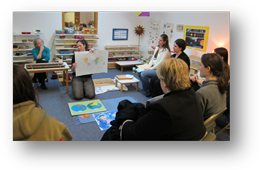
One of the biggest events this month was
the parent meeting regarding
the Kindergarten year, the final period in a primary Montessori class.
After the first Montessori year planted the seed to be nourished throughout the second year, our kindergarteners bloomed into strong and beautiful individuals. During the meeting, we presented a slide-show of our current kindergarteners to show how our students had blossomed.
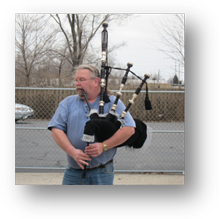
We had a very interesting visitor on St. Patrick's Day, who introduced the kids to bagpipes-a popular Irish musical instrument. The kids where really surprised and interested in it. They asked a lot of questions about the instrument: "Why does it have a bag? Why is it so loud? Is it hard to play on it?" We really appreciate Chloe's grandma for inviting her friend to share a bit of Irish culture with us.

Big Thanks to Mahi's mom, who came to us to talk about
the India Holi Day – The Festival of Colors.
Coming School Events
On the first day back from Spring Break, a wonderful transition back to school awaited us: the school field trip to the Pinocchio Musical on April 4th at the Metropolis Performing Arts Center.
On Friday, the 15th of April at 6:00 p.m., we invite the parents to our Family Friday Night: Be a Montessori Student.
The parents will have a chance to be in their children’s shoes and experience the “morning” work cycle, which includes working with materials, grace and courtesy lessons, line time, set-up and eating of dinner and, of course, the social interaction of a Montessori class.
Saturday, April 16th 11:00 a.m.-2:00 p.m. will be the second Open House
Montessori is the “Real World”
Maura Joyce, the Head of School from Montessori in the Redlands in California, posted a parent question and her response on an email list for Montessori schools. As we have heard this question before and know it can be a concern to parents who choose to send their children to Montessori Pathways, we would like to share her answer with the community.
Parent Question:
“This Montessori is all very well and good, but what about when children enter the ‘real world’; how does Montessori get them ready for the REAL world?”
Maura’s Response:
“Well, let’s define the REAL world... At your job, is everyone the exact same age? Is everyone sitting at their desks, doing the same thing at the same time? Are they doing tasks that require them to access knowledge, off the top of their heads, in a timed setting?
OR...

- Do you have different people with different levels of experience working in your office? Do you collaborate with your colleagues on projects?
- Do you need the right tools for the right jobs?
- Do you need to be able to set up work, concentrate on it, keep it organized, put it away?
- Do you have to be able to work independently, and work in a group?
- Do you need to try things and discover that they work or don’t work, this is, learn from your mistakes?
- Do you need to be able to problem solve? Communicate effectively?
Montessori IS the REAL world.
Warmly,
Miss Alena
Notes from the classroom:
Miss Jocelyn and Miss Christine
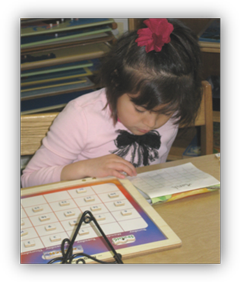
There's an old saying that "March comes in like a lion and goes out like a lamb"; let's face it......it was a beastly month although we did get to shed snowpants and such for a few days. There are signs of spring outdoors and we have enjoyed getting fresh air and sunshine whenever possible.
As adults, we often take the changing of seasons for granted; children, however, experience this change with all the wonder and excitement of a new adventure of the senses. They notice the difference in the way their environment looks smells and feels and are thrilled to experience and explore with joy and curiosity. “It smells so fresh outside” and “Look at how fast I can run now without my snow pants” were some of our favorite statements heard from the children this month! As the outdoors naturally change with each season, inside we are following the children’s natural interest by adding and changing work that creates awareness, builds skills and challenges the children in a meaningful way.

This March brought us first the day of spring, St. Patrick’s Day, a Supermoon, AND our live caterpillars arrived. In all areas of the classroom we explored hands-on activities that celebrate the world around us. On St. Patrick’s Day, several of the children noticed that as their friends arrived at school, they were wearing the color green in different shades, on different articles of clothing, with different accessories and one friend even had a green nose! Excited with this flurry of green in our environment, some older children focused their attention to writing an acrostic poem using the color word green as their theme word. Using the letters G R E E N they brainstormed words or phrases that began with each letter sound AND was green. This small group activity had the children working together and helping each other with language skills, writing and cooperating on a project.

Do you hear about the Supermoon on March 19th? This brightest full moon of the year was the perfect opportunity to explore the phases of the moon. Many children are naturally interested in the solar system, the planets and our moon visible in the night sky. The how and why the moon is in different location and changes shape builds the foundation for learning scientific vocabulary like waxing, waning, gibbous, crescent, full and new moon. Implementing basic calendar skills, several children studied March’s lunar calendar to find the day of the Supermoon, matched picture cards to learn the phases, and even created their own phases of the moon book.
Nothing says spring more than live caterpillars growing in a Montessori classroom! When our new friends arrived, they were very, very small and didn’t really move too much.
As we introduced the children to this new living observation work, we focused on the ideals of grace and courtesy; using a quiet voice near them because we are very big and they are very little and looking just with our eyes as to not disturb their habitat. Each day, the caterpillars continued to eat, continued to grow and move and the children sure noticed and talked about it with us and each other. In a little over a week several of the caterpillars began their journey into forming their chrysalis. As interest in children grew, we followed that interest and introduced many new works in the science area including parts of the caterpillar, parts of the butterfly, life cycle of the butterfly cards and stamps, non-fiction insect picture books and butterfly puzzles. When our butterflies finally emerge in April we will release them outdoors as a group, so let’s hope for some warmer weather!

In the practical life area of the classroom, new March works engaged and challenged each child to try new foods, practice some advanced food preparation skills and explore new art processes.
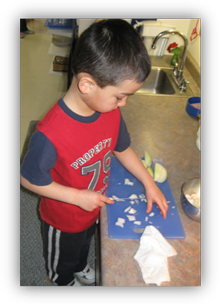
Some activities we have enjoyed in Practical Life have included making soup (so delicious and gone in a minute!), as well as tasting/comparing different foods in the classroom. We noted the various differences between broccoli and cauliflower, red grapes vs. green grapes, sampled jicama, and made guacamole from avocados. Almost every child was open to trying a new food and many requested seconds. A great opportunity at the grocery store when shopping with your child is to let them pick out and try something new. Usually, you'll find when given the opportunity to help prepare a dish, the more likely they are to eat it.
A big THANK YOU to our very generous families who have supplied items for our food tasting activities as well as some special treats we've enjoyed for snack. All the children love to help with food preparation and sharing within our school community. Thank you also for the beautiful flowers which have definitely helped brighten our classroom during this gloomy month.
With the arrival of spring, came spring break and spring camp. Our campers started the week making "rocking robins" from paper plates complete with a worm in their beaks. We learned about how robins in our climate migrate to warmer states in the fall, and are an essential sign of spring when they return. Everyone has observed robins outside and this is a sure sign that spring is here!
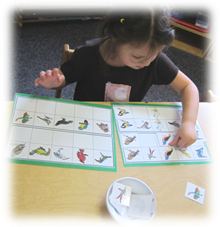
Our tiny caterpillars ate and ate and ate and as hoped and expected, spun their chrysalis' last week. On Friday, we carefully removed the lid off the container and placed the chrysalis' into their habitat which we prepared using fresh flowers, plants, and cotton balls saturated with sugar water to drink when they emerge in a few days.
This metamorphosis is a great lesson in observation and patience as well as teaching the miracle of nature. Every day, the children check their status and hopefully, soon, our Painted Lady butterflies will be ready to set free.....
To celebrate the new month of April which also has an old adage that "April showers bring May flowers", we made rain sticks and practiced turning them over slowly to replicate the sound of falling rain.
We also welcomed two new student brothers Will and James. They are a wonderful addition to our school and we will enjoy getting to know them better in the upcoming months.
We are looking forward to spring cleanup and planting outside, and hopefully some very spring like weather too!
Finally, we really enjoyed meeting with each family at our spring conferences. While these are our final scheduled conferences of this school year, we are always happy to meet individually and discuss your child’s development at anytime.
Miss Jocelyn and Miss Christine
Notes from the classroom:
Miss Karen and Miss Ambreen
Gifts of Montessori

Current research provides stronger evidence than ever that without language, math doesn’t exist. The strength of the Montessori math approach is not simply that it teaches the mathematical language necessary, but that it provides meaning for that language through beautiful, concrete, hands-on experiences with specially designed materials. New studies show that language is foundational for UNDERSTANDING math concepts. We have to actively teach specific language. Without language, children do not “just get it”. (See “Off the Shelf”).
Over this year, we have highlighted many gifts the children receive from the Montessori environment: respect, independence, and competency. The children can develop these qualities because the Montessori classroom is intentionally designed to foster these particular attributes.

The environment is prepared, orderly, and has established procedures which allow your child to function independently and, over time, to develop increasing competence and confidence.
The special gift, the over-arching goal of Montessori, is to help children develop self-control or self-regulation. Of course, we recognize that this process of developing self-control is also a lifelong process.
Very young children do not have the brain structure to regulate their behavior ---tantrums are the result. Environment helps to stabilize their emotions. That is one reason why it is so important to have a consistent, stable, and predictable environment for them.

Very young children don’t share because they cannot yet regulate their emotions. So, in our Montessori environment, for example, we can protect them from having to share.
Self regulation (or effortful control) is a behavioral system that develops in late infancy and through early childhood. It is voluntary control versus reactive behavior. It is the ability to activate or inhibit behaviors when necessary --- even when we don’t want to (use of the will). It is the ability to delay gratification and control impulses. It is the ability to meet a goal, control emotions, plan a strategy, persist at a task, and self-correct errors.
The benefits of developing self-regulation are HUGE!!! Researchers in New Zealand tracked more than 1000 people over 30 years. They assessed how they handled frustration, whether they frequently acted without thinking, and whether they could stick to a given task until finished. The more self-control the subjects exhibited as youngsters, the healthier, wealthier, and happier they were as grownups.
Unlike some factors, self-control can be taught and enhances with practice over time.

This development cannot be forced. It is a process. However, we can create opportunities for it. We can create an environment designed to promote self-regulation. Concentration is the ‘crystallizing agent’ in the process of developing self-regulation/self-control. Concentration is different than just being busily or happily occupied.
The computer, for example, does not foster self-control or self-regulation. Engagement with the computer is not effortful. It sucks us in. It does not require conscious, voluntary attention and commitment.
Concentration implies absorption and engagement. The classroom is designed to promote concentration, freely allowing time on task without interruption. Activities that promote purposeful activity fill the classroom and require a bit of effort. Children develop a love of work.

Some of the specific characteristics of the Montessori environment that promote concentration and therefore lead to self-regulation are:
- Opportunities for action and enjoyment (contrast passive reception)
- Clear goals and immediate feedback (ex. the self correcting activities in the classroom such as cylinder blocks)
- Adequate levels of skill to meet challenges (Montessori activities isolate individual skills and allow the child to practice them. Activities then combine these learned skills.)
- A structure designed for independence so children experience success, competency and control
- Offering tasks that are a correct balance between challenge and skill
Off the Shelf - The Hundred Board

One of the most popular works at this time of the year is the 100 Board. It is what it says: a square board with 100 squares (10 across and 10 down) and separate wooden tiles with the numbers 1 – 100. Initially, the task is arranging the numbers from 1 - 100 in sequence. However, for the children to be drawn to it over and over there must be multiple levels of use for the activity.
When the child first completes the 100 board, there is a real feeling of competence, satisfaction and accomplishment. They have seen other children finish it and now they too conquered a milestone work. In fact, they often will come into the classroom several days in a row and want to repeat the activity.
So what else can the children do in addition to sequencing numbers 1 – 100?

- They work with patterns of numbers. For example, let’s count every 4th number and put a marker over it. (4, 8, 12, 16, etc.). This “skip counting” lays the base for the answers in multiplication. Because we mark the answer numbers on the board with a disk, it also shows patterns of numbers.
- We can add using the number board for reference: 2 + 8; 43 + 9; etc. because it functions like an extended number line. Children can also move the opposite way on the board and do subtraction problems.
- We can add by ten starting with various numbers: 11, 21, 31, 41, etc. This will also show as a pattern on the 100 board.
- We can find the doubles of numbers 11, 22, 33, 44, 55, etc. which will show a pattern on the 100 board.
- We can “hide” a number by turning it over. The child will have to identify the number turned over by its relationship to neighboring numbers: “I knew it was 23 because it came after 22 and before 24.
- The extended list of activities is almost limitless and therefore encourages children to return to the activity at varying levels of understanding and challenge.
Taking It Home
More on using the helpful “Language of Limits” from the book The Hidden Hinge
-
Be objective, not personal in your instructions: “Books go in this bookcase.”
Rather than:” I want you to be sure to keep your books in the bookcase.”
-
Give a solution to the problem rather than a mere prohibition: “Please move to this side of the table, John, so that Mary will be able to see.”
Rather than: “Don’t stand in the way John.”
-
Be specific. Give concrete information using concrete names and commands: “If you hold the card by its edge, it will stay clean”.
Rather than: “Don’t mess up the cards.”
“The best instruction is that which uses the least amount of words sufficient for the task."
Maria Montessori
Miss Karen and Miss Ambreen
Kindergarten Extended Day
Curriculum

We have continued the science curriculum by returning to our categorization of invertebrates and vertebrates and then looking more closely at some of the members of each category.
We looked closely at worms, actually watching them, holding them and learning about some of their behaviors and attributes. Yes, some of the children love holding worms (others not so much). But this close-up look allowed us to observe their movements, body parts, etc.
We will continue to watch our “exhibit” of caterpillars turning into butterflies. We can observe the whole process including the making of the chrysalis and, if we are lucky, we can actually observe the butterflies as they emerge from the chrysalis. After they all emerge and strengthen their wings, we will ceremoniously release them outdoors.

We began our vertebrate study with fish: their common characteristics and needs. We brought in smoked fish to prepare for tasting. As we prepared the fish, we could see the backbone running through the fish body, the actual gills, fins, scales (typical of fish, but not necessary). That lead to such topics as living in water, breathing, various means of protection, how fins help the fish move, etc. And yes, many children loved the taste of smoked fish and asked for more! A new menu possibility for your family.
We will continue our study with amphibians, moving on to reptiles.
Unplanned Science
Earlier this week we had a small flood in the classroom. Actually it evolved quite naturally as the children created their own experiment. It began with one girl filling the hand washing bowl to the brim. One of the boys in the classroom noticed and said : “You can’t put your hand in the bowl. It will overflow.”
The girl took the contrary position and cautiously lowered one hand into the bowl. Vindicated! It did not overflow.
The boy: “Yeah, but you can’t put your other hand into the bowl.” Cautiously she lowered the other hand into the water. It produced a small trickle of water from the bowl. “I told you! I bet we can’t put more hands into the bowl!” the boy said.
This aroused the interest of two more children. Slowly they would add another hand to the bowl increasing the trickle. “This is so cool. It’s our own overflow science experiment.” One by one hands went into the bowl of water. “We better get some towels in case we have an emergency”. So they got a pile of towels. Eventually it led to adding another pitcher of water. “Wow. Now it’s a waterfall!” (Water ran out of the bowl, over the edge of the stand and onto the floor.
Soon, they worked together to dry the floor, the stand, etc. and take the wet towels down to the laundry. “That was sooooooo cool. We made our own experiment.”
Logical thinking
On another topic, we played the guessing game 20 questions and discussed how asking a “broad” question (ex. Is it an animal?) gives so much more information than a very specific question (ex. Is it a fish?). If we got an answer to a broad question, that could eliminate so many possibilities. If we got an answer to a very specific question, it could eliminate only one possibility. Then we practiced. It was amazing how so many of the children caught on right away.
Artist of the Month
We are continuing to study and do an additional project related to Marc Chagall. I hope you have been able to observe the “stained glass window” effect from our latest project. The children’s work is hanging in the window of the south room and the office window.
We will be moving on to Wassily Kandinsky who has done some very interesting work relating art and music. More on that next month.
Field Trips

Our “indoor” field trip was such a success. All the children were engaged in the stories that our visitors Abraham Lincoln and his wife Mary Todd had to tell.
Both were in period dress. Particular fascinating, of course, were the things that related directly to their life as children: chores that Lincoln did as a child, what is missing when you have no electricity, means of travel---horseback, and so on.
Lincoln was an inspiration to us all. He explained his philosophy that you simply do not quit if you do not succeed right away. There were many challenges in his life that he had to overcome. Abraham, for example, was afraid to ask Mary to dance. He couldn’t do it well of course, and stepped all over her feet.
During our afternoon with them though, they provided a small example of their dancing now that he had learned.
His wife Mary, spoke a lot about various foods she made (never heard of pizza! Or hot dogs. Or tacos, etc.). She also had fascinating things to show us, the hoops of her underskirt, her many buttons (no zippers or velcro). She explained why it often took an hour or more just to get dressed. That led to discussion on staying cool in summer (no air-conditioning); how particular fabrics kept them cooler in summer, how they stayed indoors in summer until the cooler evening, etc.

The children were engaged throughout and offered many thoughtful questions. Finally, it was time to say good-bye to our guests. Right before leaving, Abraham Lincoln offered two children the opportunity to test his beard to see if it was real. Ouch. It was real. We ended by gathering together for a group photo.
This week will be another “indoor” field trip as we have invited Helen ----and her assistant from Africa, to come and do drumming with us. Report to follow.
Weaving

The children totally enjoyed weaving their St. Patrick’s Day placemats this month. It was amazing how much easier it was for all! Even noticeable from last month when we did the valentine placemats. They loved figuring out a pattern (or not) and enjoyed the art aspect of it. They took the math aspect for granted: alternating the weaving rows, alternating the over and under, creating repeating patterns.
Miss Karen
Notes from the classroom:
Miss Terri and Miss Donna
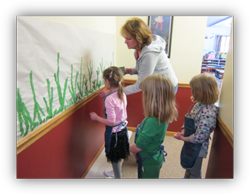
Spring has sprung! In the afternoon class we celebrated by making a spring flower banner. We painted green stems and leaves and added flowers on top. We cut out circles from squares of assorted spring-colored paper.
Next we made caterpillars using the same idea. We used squares of colored paper and began snipping off all the corners so they turned into circles and we glue them all together. Then we glue the colorful caterpillar to a leaf and added a face and many legs.
We also made lots of new play dough. We found different combinations on the box of food coloring so we added blue and green food coloring to make turquoise.

We’ve been enjoying reading Ms. Terri’s book of classic nursery rhymes. Our favorite is Humpty Dumpty. We made our own picture to take home. First, we sponge painted the brick wall with red and brown paint. Then, we traced the oval inset for Humpty Dumpty, cut him out and drew a face and clothes. Lastly, we added arms and legs and glued him to the wall so we won’t fall off.
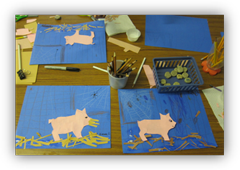
After we finished reading Charlotte’s Web, we made a picture of Wilbur the pig and cut up some straw for his pen. We drew a spider’s web in the corner with a white pencil and added Charlotte to complete the picture.
We have a new game in our classroom called Story Blocks. Mr. Wagler graciously cut pieces of wood into 1 ½ inch pieces of wood for us. The children cut out assorted pictures from magazines which we glued on each of the six sides of the cube. The game is played by rolling three random cubes (like dice) and then telling a story about the pictures shown. We are really learning to use our imagination by making up interesting stories.
The kindergarteners have been busy in the PM too. After studying invertebrates an extended day, they made beautiful bugs and butterflies to decorate the hallway for the kindergarten-parent meeting.
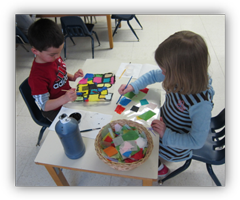
We had also studied Mark Chagall as our artist of the month. We made our own stain-glass windows using tissue paper and transparency film (anyone remember overhead projectors?) The children cut out assorted colored tissue paper and carefully glued each piece in place with watered-down clear Elmer’s glue. Then, we added glue on top to make the shiny. When the glue dried, we painted black acrylic paint (again, very carefully) around each piece to make our own stain-glass window. These works can also be seen throughout the school.
For baking and snack time we have been enjoying a lot of our favorites. Banana bread, carrot cake and apple sauce are familiar, fun to make and you can smell throughout the school. We’ve also been sampling yogurt, both vanilla and plain to which we add different flavors of jam. Dehydrated apples and bananas are also regular snacks along with crackers. We made an apple-cranberry tart during Spring Break which we enjoyed for a couple of days. The recipe called for 8 tart apples, cored, peeled and sliced very thin. It was a lot of work but the kids are amazing and stayed with it until the recipe is complete. Some children weren’t so sure about apples on pizza dough but we all found it to be delicious.
The Spring Break group of children helped to make a reading corner this past week.

First, we had to rearrange some of the classroom furniture (which was fun) and then we found a spare book shelf, book racks and more books.
A friend of Ms. Terri, named Ms. Mary, knitted us a three-foot circular rug out of the spare yarn she had. We found extra pillows and we are also having Ms. Mary make us more pillow covers. It was fun stuffing the new pillows – the children called the stuffing “clouds.”
We’ve been enjoying taking turns in our new reading corner after washing our hands and taking off our shoes. Several children have told me they made their own cozy reading corner at home. Anything to encourage young readers is great (even a sheet over a card table works). Oh well, use your imagination and don’t forget to read, read, read.
Gym Class with Ms. Donna
March had us continuing our loco-motor skills, as well as throwing and catching a ball with a partner. We also began leaping or jumping over folded mates and jumping over the long jump rope as it was wiggling on the floor.
Stations were introduced this month. Children were assigned a station for a certain amount of time. When time was called they had to make sure that their station was set up for the next group before they could move on.
The stations were ski jump (you jumped over a jump rope on the ground keeping your feet together), throwing bean bags underhand and overhand into a small ring inside of a hula hoop, scooter trail (following a path while sitting on the scooter just using your legs and then following the path laying on the scooter using your arms and legs, and our last station was crawling through tunnels.
Miss Terri and Miss Donna
